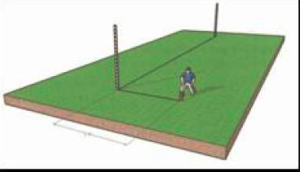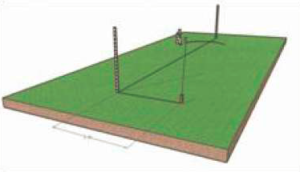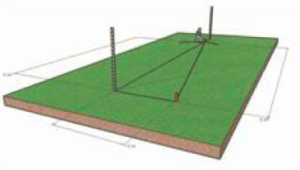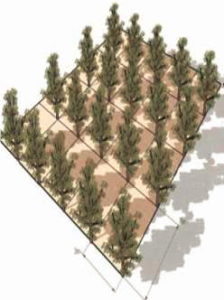Horticulture Guruji
Exercise 11
To study the layout and planting of orchard
The arrangement of plants in the orchard is called layout. The following points should be considered before choosing a planting system.
- It should have the maximum number of plants per unit area.
- It should have enough space for each tree to grow.
- This makes possible an equitable distribution of the area under each tree.
- Interculture works like weeding, spraying, etc. can be done easily.
- It makes supervision easier and more effective.
Systems of Orchard Layout
1) Square system:
|
 |
Procedure for layout:
|
Step No.-1: ABCD is the area where the trees are to be planted. The first step would be to establish a baseline. Select a baseline parallel to the boundary of the road or fence or orchard. It should be drawn at half the distance that the planting distance is to be maintained. For example, if the distance is 10 meters, the baseline should be drawn at a distance of 5 meters from the periphery of the plot. |
 |
Step No.-2: Towards the end of the baseline again leave half a gap from the boundary or road or fence etc. and put the peg at one end of the baseline. Measure one planting distance from this peg and place the other peg on the baseline.
Thus, continue to place pegs at each planting distance until the total length of the baseline is covered. The distance from the last peg to the border should also be half the distance.
Step No.-3: Draw perpendicular lines from the first peg to the baseline and the last peg.
perpendicular lines can be drawn by adopting the following method.
Pythagoras theorem method: A perpendicular line can be drawn by adopting a right-angled triangle with sides and hypotenuse in the ratio 3:4:5.
|
· Measure a known distance in the proportion of 3 from the first peg on the baseline and mark the point · From the first peg, measure the distance in a proportion of 4 and draw an arc away from the baseline. |
 |
|
·From the point marked on the first baseline, now measure the distance in proportion 5 and make a second arc intersecting the first. |
 |
|
· Now extend a straight line from the position of the first peg through the point of intersection of the two arcs. This gives a vertical line from the position of the first peg to the baseline. |
 |
Merits and demerits:
1) The most used and simplest system of layout
2) Possibility of conducting inter-culture operations in both directions is the biggest advantage of this system.
3) The major disadvantage of this system is that a lot of space is wasted in the center of each square.
2) Rectangular system:
|
 |
Procedure for layout:
Step numbers: 1, 2 and 3 are the same as in the square system.
Step No. 4: Mark the planting position on both the vertical lines following the spacing to be adopted between the rows.
Step number 5: This is similar to the square system, but with the spacing to be adjusted between the rows.
Merits and demerits:
- It has almost all the advantages of the square system but cultivation is somewhat difficult especially when the trees are fully grown.
3) Quincunx or filler system:
|
 |
This method is followed when the distance between permanent trees is 8 m or more or where the growth of permanent trees is very slow and fruiting takes a long time. Like Sapota, Jackfruit.
Procedure for layout:
Procedure for lay out:
Step No.-1: Lay as the Square System
Step No.-2: Draw the diagonals of each square.
Step No.-3: Mark the planting position of the filler tree by placing a peg at the point of intersection of the two diagonals in each square.
Merits and demerits:
- The main advantage of this system is that the plant population is about to double that of the square system.
- The greatest disadvantage of this system is that it is difficult to carry out intercultural operations on account of the filler tree.
4) Hexagonal system:
|
 |
Procedure for layout: Steps-
- In the case of a square system mark the four sides with the distances shown in the sketch. Trace the position of the plants in the first row as well.
- Take the rope a little longer than twice the distance between the plants.
- Put a knot in the middle, so that the length of the rope on either side of the knot is equal to the distance from the tree to tree or
- Take an iron chain with a ring in the middle and a length equal to the distance from the tree to tree.
- Hold the ends of each rope or chain in the position of two consecutive plants in the first row, and stretch from the center to give an equilateral triangle, and thus the position of one plant on the second row.
- In this way, the area is laid out.
Merits and demerits:
- This system allows interculture in all three directions.
- Plants completely occupy the land without leaving any free space as in a square system
- In this system 15% more plants are taken as compared to the square planting system.
- This system is generally not used as it is difficult to layout and inter-culture operation in such orchards is difficult.
References cited
- Commercial Fruits. By S. P. Singh
- A text book on Pomology, Vol,1. by T. K. Chattapadhya
- Tropical Horticulture, Vol.1, by T. K. Bose, S. K. Mitra, A. A. Farooqui and M. K. Sadhu
